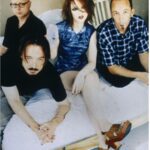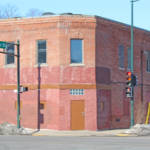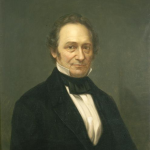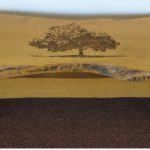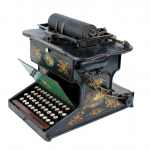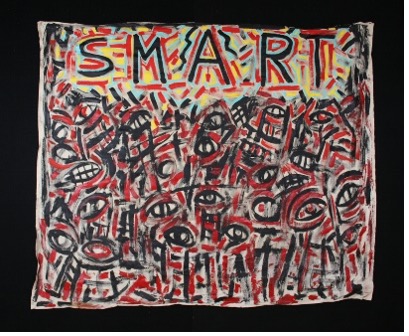
Not many people would expect that some of the most legendary music of the late twentieth and early twenty first century was made right here in Wisconsin. During its twenty-seven years of operation, Madison’s Smart Studios was a cornerstone of the music scene, responsible for producing a wide array of music all the way from unknown local acts to big-name artists from around the globe.
The story of the “SMART” banner begins with the inception of Smart Studios in 1983. During this time, Butch Vig and Steve Marker, two friends and musicians from the University of Wisconsin–Madison, opened Smart Studios’ first official location in the Gisholt building on East Washington Avenue, right down the hall from Madison-based artist Dennis Nechvatal’s studio. In their first year of operation, Nechvatal created the “SMART” banner for his new neighbors, which hung inside Smart Studios as a decorative backdrop.
The “SMART” banner is hand-painted on a large, white, cotton textile canvas. It features the title “SMART” in bold letters at the top and a collection of disembodied eyes and mouths below, contrasting each other with the former being bright and eye-catching and the latter being dark and crazed. Compared to Nechvatal’s other pieces of art, the “SMART” banner somehow manages to be both similar to and different from his usual style. Nechvatal (who is still active as an artist) often paints detailed images of nature with a heavy emphasis on blues and greens—as opposed to wild splatters of black and red. However, there is still an element of chaos and surrealism in his work that is clearly reflected in the “SMART” banner.
In their early years, the music produced in Smart Studios largely consisted of gritty genres such as punk, rock, and grunge—working with bands such as Killdozer, Tar Babies, Die Kreuzen, and so on. In essence, Smart helped make music that was fast, harsh, loud, and counter-cultural. Nechvatal reflected this frenzied sort of noise in the “SMART” banner’s design, creating an apt representation of the studio in the form of a painted cotton canvas.
Smart Studios grew as time went on, eventually moving from the Gisholt building in 1987 to their permanent location across the street at 1254 East Washington Avenue. Their success took off after recording with Nirvana in 1990, and they went on to work with more well-known acts over the next two decades, such as The Smashing Pumpkins, Garbage, L7, Fall Out Boy, and Death Cab for Cutie, to name just a few. The studio closed its doors in 2010, and the “SMART” banner was relocated to the Wisconsin Historical Society. It lives on as a piece of Smart Studios, which cemented their legacy in Madison as an unexpected hot spot for great music.
Written by Kaylee Bittner, June 2022
SOURCES
“Artist Biography & Facts: Dennis Nechvatal.” Dennis Nechvatal – Biography, https://www.askart.com/artist/Dennis_Nechvatal/101627/Dennis_Nechvatal.aspx.
Berkenstadt, Jim. “Smart Studios: A History.” Smart Geeks, 2009, http://www.smartgeeks.com/smart.html.
Bonesteel, Michael. “Michael Bonesteel on Dennis Nechvatal.” The Online Edition of Artforum International Magazine, 1 Nov. 1982, https://www.artforum.com/print/reviews/198209/dennis-nechvatal-65602.
Graff, Gary. “Butch Vig on the Making of Nirvana’s Pivotal ‘Nevermind’ and New Doc ‘The Smart Studios Story’: Exclusive Video.” Billboard, 15 Mar. 2016, https://www.billboard.com/music/rock/butch-vig-on-nirvana-nevermind-the-smart-studios-story-exclusive-clip-7262662/.
Schneider, Wendy, director. The Smart Studios Story. Prime Video, 2017, https://www.amazon.com/Smart-Studios-Story-Butch-Vig/dp/B01MSD47XU. Accessed 10 Mar. 2022.
